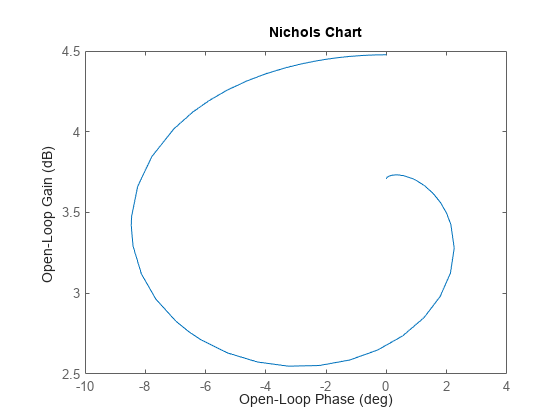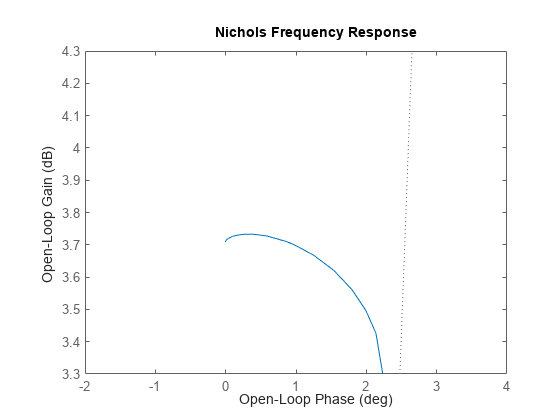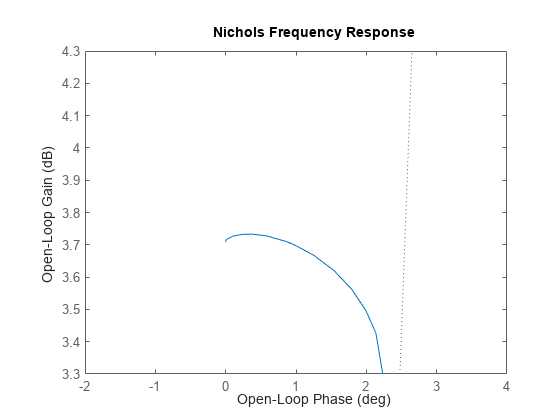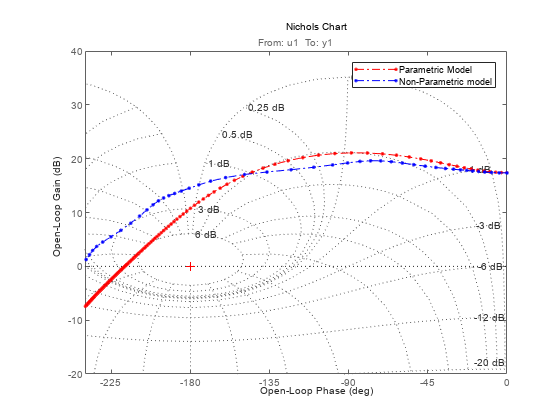nicholsplot
Plot Nichols frequency response of dynamic system
Description
The nicholsplot function plots the Nichols response of a dynamic
system model and returns a NicholsPlot chart object. To customize the plot,
modify the properties of the chart object using dot notation. For more information, see Customize Linear Analysis Plots at Command Line.
To obtain frequency response data, use nichols.
Creation
Syntax
Description
np = nicholsplot(sys)sys and returns the corresponding chart object.
If sys is a multi-input, multi-output (MIMO) model, then
nicholsplot produces a grid of Nichols plots with each plot
displaying the frequency response of one input-output pair.
If sys is a model with complex coefficients, then
nicholsplot shows a contour comprised of both positive and negative
frequencies. For models with real coefficients, nicholsplot shows only
positive frequencies.
np = nicholsplot(___,w)w. You can
specify a frequency range or a vector of frequencies. You can use w
with any of the previous syntaxes.
You can use w with any of the input-argument combinations in
previous syntaxes.
See logspace to generate logarithmically
spaced frequency vectors.
np = nicholsplot(___,plotoptions)plotoptions. Settings you specify in
plotoptions override the plotting preferences for the current
MATLAB® session. This syntax is useful when you want to write a script to generate
multiple plots that look the same regardless of the local preferences.
np = nicholsplot(parent,___)Figure or TiledChartLayout, and sets the
Parent property. Use this syntax when you want to create a plot
in a specified open figure or when creating apps in App Designer.
Input Arguments
sys — Dynamic system
dynamic system model | model array
Dynamic system, specified as a SISO or MIMO dynamic system model or array of dynamic system models. Dynamic systems that you can use include:
Continuous-time or discrete-time numeric LTI models, such as
tf,zpk, orssmodels.Sparse state-space models, such as
sparssormechssmodels. Frequency gridwmust be specified for sparse models.Generalized or uncertain LTI models such as
genssoruss(Robust Control Toolbox) models. Using uncertain models requires Robust Control Toolbox™ software.For tunable control design blocks, the function evaluates the model at its current value to plot the response.
For uncertain control design blocks, the function plots the nominal value and random samples of the model.
Frequency-response data models such as
frdmodels. For such models, the function plots the response at the frequencies defined in the model.Identified LTI models, such as
idtf(System Identification Toolbox),idss(System Identification Toolbox), oridproc(System Identification Toolbox) models. Using identified models requires System Identification Toolbox™ software.
If sys is an array of models, the plot shows responses of all models in
the array on the same axes.
LineSpec — Line style, marker, and color
string | character vector
Line style, marker, and color, specified as a string or character vector containing symbols. The symbols can appear in any order. You do not need to specify all three characteristics (line style, marker, and color). For example, if you omit the line style and specify the marker, then the plot shows only the marker and no line.
Example: '--or' is a red dashed line with circle markers
| Line Style | Description |
|---|---|
"-" | Solid line |
"--" | Dashed line |
":" | Dotted line |
"-." | Dash-dotted line |
| Marker | Description |
|---|---|
"o" | Circle |
"+" | Plus sign |
"*" | Asterisk |
"." | Point |
"x" | Cross |
"_" | Horizontal line |
"|" | Vertical line |
"s" | Square |
"d" | Diamond |
"^" | Upward-pointing triangle |
"v" | Downward-pointing triangle |
">" | Right-pointing triangle |
"<" | Left-pointing triangle |
"p" | Pentagram |
"h" | Hexagram |
| Color | Description |
|---|---|
"r" | red |
"g" | green |
"b" | blue |
"c" | cyan |
"m" | magenta |
"y" | yellow |
"k" | black |
"w" | white |
w — Frequencies
{wmin,wmax} | vector | []
Frequencies at which to compute and plot frequency response, specified as the cell array {wmin,wmax} or as a vector of frequency values.
If
wis a cell array of the form{wmin,wmax}, then the function computes the response at frequencies ranging betweenwminandwmax.If
wis a vector of frequencies, then the function computes the response at each specified frequency. For example, uselogspaceto generate a row vector with logarithmically spaced frequency values. The vectorwcan contain both positive and negative frequencies.[]— Automatically select frequencies based on system dynamics.
For models with complex coefficients, if you specify a frequency range of [wmin,wmax] for your plot, then the plot shows a contour comprised of both positive frequencies [wmin,wmax] and negative frequencies [–wmax,–wmin].
Specify frequencies in units of rad/TimeUnit, where TimeUnit is the TimeUnit property of the model.
plotoptions — Nichols plot options
nicholsoptions object
Nichols plot options, specified as a nicholsoptions object. You can use these options to customize the Nichols
plot appearance. Settings you specify in plotoptions override the
preference settings for the current MATLAB session.
parent — Parent container
Figure object (default) | TiledChartLayout object | UIFigure object | UIGridLayout object | UIPanel object | UITab object
Parent container of the chart, specified as one of the following objects:
FigureTiledChartLayoutUIFigureUIGridLayoutUIPanelUITab
Properties
Note
The properties listed here are only a subset. For a complete list, see NicholsPlot Properties.
Responses — Model responses
NicholsResponse object | array of NicholsResponse objects
Model responses, specified as a NicholsResponse object or an array of such objects. Use this property to modify the dynamic system model or appearance for each response in the plot. Each NicholsResponse object has the following fields.
SourceData — Source data
structure
Source data for the response, specified as a structure with the following fields.
Model — Dynamic system
dynamic system model | model array
Dynamic system, specified as a SISO or MIMO dynamic system model or array of dynamic system models.
When you initially create a plot, Model matches the value you specify for sys.
FrequencySpec — Frequencies
{wmin,wmax} | vector | []
Frequencies at which to compute the response, specified as one of the following:
Cell array of the form
{wmin,wmax}— Compute the response at frequencies in the range fromwmintowmax.Vector of frequencies — Compute the response at each specified frequency. For example, use
logspaceto generate a row vector with logarithmically spaced frequency values. The vectorwcan contain both positive and negative frequencies.[]— Automatically select frequencies based on system dynamics.
Specify frequencies in units of rad/TimeUnit, where TimeUnit is the TimeUnit property of the model.
When you initially create a plot:
FrequencySpecmatches the value you specify for thewargument.If you do not specify
w,FrequencySpecis empty and frequencies are selected based on the system dynamics.
Name — Response name
string | character vector
Response name, specified as a string or character vector and stored as a string.
Visible — Response visibility
"on" (default) | on/off logical value
Response visibility, specified as one of the following logical on/off values:
"on",1, ortrue— Display the response in the plot."off",0, orfalse— Do not display the response in the plot.
The value is stored as an on/off logical value of type matlab.lang.OnOffSwitchState.
LegendDisplay — Option to list response in legend
"on" (default) | on/off logical value
Option to list response in legend, specified as one of the following logical on/off values:
"on",1, ortrue— List the response in the legend."off",0, orfalse— Do not list the response in the legend.
The value is stored as an on/off logical value of type matlab.lang.OnOffSwitchState.
MarkerStyle — Marker style
"none" | "o" | "+" | "*" | "." | ...
Marker style, specified as one of the following values.
| Marker | Description |
|---|---|
"none" | No marker |
"o" | Circle |
"+" | Plus sign |
"*" | Asterisk |
"." | Point |
"x" | Cross |
"_" | Horizontal line |
"|" | Vertical line |
"s" | Square |
"d" | Diamond |
"^" | Upward-pointing triangle |
"v" | Downward-pointing triangle |
">" | Right-pointing triangle |
"<" | Left-pointing triangle |
"p" | Pentagram |
"h" | Hexagram |
Color — Plot color
RGB triplet | hexadecimal color code | color name
Plot color, specified as an RGB triplet or a hexadecimal color code and stored as an RGB triplet.
Alternatively, you can specify some common colors by name. The following table lists these colors and their corresponding RGB triplets and hexadecimal color codes.
| Color Name | RGB Triplet | Hexadecimal Color Code |
|---|---|---|
| [1 0 0] | #FF0000 |
| [0 1 0] | #00FF00 |
| [0 0 1] | #0000FF |
| [0 1 1] | #00FFFF |
| [1 0 1] | #FF00FF |
| [1 1 0] | #FFFF00 |
| [0 0 0] | #000000 |
| [1 1 1] | #FFFFFF |
LineStyle — Line style
"-" | "--" | ":" | "-."
Line style, specified as one of the following values.
| Line Style | Description |
|---|---|
"-" | Solid line |
"--" | Dashed line |
":" | Dotted line |
"-." | Dash-dotted line |
MarkerSize — Marker size
positive scalar
Marker size, specified as a positive scalar.
LineWidth — Line width
positive scalar
Line width, specified as a positive scalar.
Characteristics — Response characteristics
CharacteristicsManager object
Response characteristics to display in the plot, specified as a
CharacteristicsManager object with the following properties.
FrequencyPeakResponse — Visibility of peak response
CharacteristicOption object
Visibility of peak response in plot, specified as a CharacteristicOption
object with the following property.
Visible — Peak response visibility
"off" (default) | on/off logical value
Peak response visibility, specified as one of the following logical on/off values:
"on",1, ortrue— Display the peak response."off",0, orfalse— Do not display the peak response.
The value is stored as an on/off logical value of type matlab.lang.OnOffSwitchState.
AllStabilityMargins — Visibility of all stability margins
CharacteristicOption object
Visibility of all stability margins, specified as a CharacteristicOption
object with the following property.
Visible — Margin visibility
"off" (default) | on/off logical value
Margin visibility, specified as one of the following logical on/off values:
"on",1, ortrue— Display the margins."off",0, orfalse— Do not display the margins.
The value is stored as an on/off logical value of type matlab.lang.OnOffSwitchState.
MinimumStabilityMargins — Visibility of minimum stability margins
CharacteristicOption object
Visibility of minimum stability margins, specified as a CharacteristicOption
object with the following property.
Visible — Margin visibility
"off" (default) | on/off logical value
Margin visibility, specified as one of the following logical on/off values:
"on",1, ortrue— Display the margins."off",0, orfalse— Do not display the margins.
The value is stored as an on/off logical value of type matlab.lang.OnOffSwitchState.
FrequencyUnit — Frequency units
"rad/s" | "Hz" | "rpm" | ...
Frequency units, specified as one of the following values:
"Hz""rad/s""rpm""kHz""MHz""GHz""rad/nanosecond""rad/microsecond""rad/millisecond""rad/minute""rad/hour""rad/day""rad/week""rad/month""rad/year""cycles/nanosecond""cycles/microsecond""cycles/millisecond""cycles/hour""cycles/day""cycles/week""cycles/month""cycles/year"
Dependencies
By default, the response uses the frequency units of the plotted linear system. You can override the default units by specifying toolbox preferences. For more information, see Specify Toolbox Preferences for Linear Analysis Plots.
MagnitudeUnit — Magnitude units
"dB" | "abs"
Magnitude units, specified as one of the following:
"dB"— Decibels"abs"— Absolute value
Dependencies
The default magnitude units depend on the toolbox preferences. For more information, see Specify Toolbox Preferences for Linear Analysis Plots.
PhaseUnit — Phase units
"deg" | "rad"
Phase units, specified as one of the following:
"deg"— Degrees"rad"— Radians
Dependencies
The default phase units depend on the toolbox preferences. For more information, see Specify Toolbox Preferences for Linear Analysis Plots.
PhaseWrappingEnabled — Option to enable phase wrapping
on/off logical value
Option to enable phase wrapping, specified as one of the following logical on/off values:
"on",1, ortrue— Enable phase wrapping. The phase shown in the response wraps to remain in the range defined byPhaseWrappingBranch."off",0, orfalse— Disable phase wrapping.
The value is stored as an on/off logical value of type matlab.lang.OnOffSwitchState.
Dependencies
The default phase-wrapping configuration depends on the toolbox preferences. For more information, see Specify Toolbox Preferences for Linear Analysis Plots.
When both phase wrapping and phase matching are enabled, the software performs the phase matching followed by the phase wrapping.
PhaseWrappingBranch — Lower limit of phase-wrapping range
scalar
Lower limit of phase-wrapping range, specified as a scalar value in degrees. The phase-wrapping range is [B,B+360), where B is equal to PhaseWrappingBranch.
Dependencies
This value is ignored when
PhaseMatchingEnabledis"off".The default phase-wrapping configuration depends on the toolbox preferences. For more information, see Specify Toolbox Preferences for Linear Analysis Plots.
PhaseMatchingEnabled — Option to enable phase matching
"off" (default) | on/off logical value
Option to enable phase matching, specified as one of the following logical on/off values:
"on",1, ortrue— Enable phase matching such that the phase response matches the value specified inPhaseMatchingValueat the frequency specified inPhaseMatchingFrequency. The remaining phase response shifts to maintain the same phase profile."off",0, orfalse— Disable phase matching.
The value is stored as an on/off logical value of type matlab.lang.OnOffSwitchState.
Dependencies
When both phase wrapping and phase matching are enabled, the software performs the phase matching followed by the phase wrapping.
PhaseMatchingFrequency — Phase matching frequency
0 (default) | scalar
Phase matching frequency, specified as a scalar.
Dependencies
This value is ignored when PhaseMatchingEnabled is "off".
PhaseMatchingValue — Phase matching response value
0 (default) | scalar
Phase matching response value, specified as a scalar.
Dependencies
This value is ignored when PhaseMatchingEnabled is "off".
MinimumGainEnabled — Option to enable minimum gain
"off" (default) | on/off logical value
Option to enable minimum gain for plotting, specified as one of the following logical on/off values:
"on",1, ortrue— Set the minimum gain for plotting to theMinimumGainValueproperty value."off",0, orfalse— Set the minimum gain for plotting automatically based on the system dynamics.
The value is stored as an on/off logical value of type matlab.lang.OnOffSwitchState.
Dependencies
The default minimum-gain configuration depends on the toolbox preferences. For more information, see Specify Toolbox Preferences for Linear Analysis Plots.
MinimumGainValue — Minimum gain value
0 (default) | scalar
Minimum gain value for plotting, specified as a scalar.
Dependencies
To apply the minimum gain value, set the
MinimumGainEnabledproperty to"on".The default minimum-gain configuration depends on the toolbox preferences. For more information, see Specify Toolbox Preferences for Linear Analysis Plots.
Dependencies
Visible — Chart visibility
"on" (default) | on/off logical value
Chart visibility, specified as one of the following logical on/off values:
"on",1, ortrue— Display the chart."off",0, orfalse— Hide the chart without deleting it. You still can access the properties of chart when it is not visible.
The value is stored as an on/off logical value of type matlab.lang.OnOffSwitchState.
IOGrouping — Grouping of inputs and outputs pairs
"none" (default) | "inputs" | "outputs" | "all"
Grouping of inputs and outputs pairs, specified as one of the following:
"none"— Do not group inputs or outputs."inputs"— Group only inputs."outputs"— Group only outputs."all"— Group all input-output pairs.
InputVisible — Option to display inputs
on/off logical value | array of on/off logical values
Option to display inputs, specified as one of the following logical on/off values or an array of such values:
"on",1, ortrue— Display the corresponding input."off",0, orfalse— Hide the corresponding input.
InputVisible is an array when the plotted system has multiple inputs. By
default, all inputs are visible in the plot.
The value is stored as an on/off logical value of type matlab.lang.OnOffSwitchState or an array of such values.
OutputVisible — Option to display outputs
on/off logical value | array of on/off logical values
Option to display outputs, specified as one of the following logical on/off values or an array of such values:
"on",1, ortrue— Display the corresponding output."off",0, orfalse— Hide the corresponding output.
OutputVisible is an array when the plotted system has multiple outputs.
By default, all outputs are visible in the plot.
The value is stored as an on/off logical value of type matlab.lang.OnOffSwitchState or an array of such values.
Object Functions
addResponse | Add dynamic system response to existing response plot |
showConfidence (System Identification Toolbox) | Display confidence regions on response plots for identified models |
Examples
Customize Nichols Plot
For this example, use the plot handle to change the title, turn on the grid, and set axis limits.
Generate a random state-space model with 5 states and create the Nichols plot with chart object np.
rng("default")
sys = rss(5);
np = nicholsplot(sys);
Change the title, enable the grid, and set axis limits.
np.Title.String = "Nichols Frequency Response"; xlim([-2 4]) ylim([3.3 4.3]) grid on

Alternatively, you can also use the nicholsoptions command to specify the required plot options. First, create an options set based on the toolbox preferences.
plotoptions = nicholsoptions('cstprefs');Change the desired properties of the options set.
plotoptions.Title.String = 'Nichols Frequency Response'; plotoptions.Grid = 'on'; plotoptions.XLim = {[-2,4]}; plotoptions.YLim = {[3.3,4.3]}; nicholsplot(sys,plotoptions);

Depending on your own toolbox preferences, the plot you obtain might look different from this plot. Only the properties that you set explicitly, in this example Title, Grid, XLim and YLim, override the toolbox preferences.
Custom Nichols Plot Settings Independent of Preferences
For this example, create a Nichols plot that uses 15-point red text for the title. This plot should look the same, regardless of the preferences of the MATLAB session in which it is generated.
First, create a default options set using nicholsoptions.
plotoptions = nicholsoptions;
Next, change the required properties of the options set plotoptions.
plotoptions.Title.FontSize = 15; plotoptions.Title.Color = [1 0 0]; plotoptions.FreqUnits = 'Hz'; plotoptions.Grid = 'on';
Now, create a Nichols plot using the options set plotoptions.
nicholsplot(tf(1,[1,1]),{0,15},plotoptions);
Because plotoptions begins with a fixed set of options, the plot result is independent of the toolbox preferences of the MATLAB session.
Customized Nichols Plot of Transfer Function
For this example, create a Nichols plot of the following continuous-time SISO dynamic system. Then, turn the grid on and rename the plot.
Create the transfer function sys.
sys = tf([1 0.1 7.5],[1 0.12 9 0 0]);
Next, create the options set using nicholsoptions and change the required plot properties.
plotoptions = nicholsoptions; plotoptions.Grid = 'on'; plotoptions.Title.String = 'Nichols Plot of Transfer Function';
Now, create the Nichols plot with the custom option set plotoptions.
nicholsplot(sys,plotoptions)

nicholsplot automatically selects the plot range based on the system dynamics.
Customized Nichols Plot of MIMO System
For this example, consider a MIMO state-space model with 3 inputs, 3 outputs and 3 states. Create a Nichols plot with phase units in radians.
Create the MIMO state-space model sys_mimo.
J = [8 -3 -3; -3 8 -3; -3 -3 8]; F = 0.2*eye(3); A = -J\F; B = inv(J); C = eye(3); D = 0; sys_mimo = ss(A,B,C,D); size(sys_mimo)
State-space model with 3 outputs, 3 inputs, and 3 states.
Create a Nichols plot with chart object np.
np = nicholsplot(sys_mimo);

Set the phase unit ad radians.
np.PhaseUnit = "rad";
The Nichols plot automatically updates when you modify the chart object. For MIMO models, nicholsplot produces an array of Nichols plots, each plot displaying the frequency response of one I/O pair.
Nichols Response of Identified Parametric and Nonparametric Models
For this example, compare the Nichols response of a parametric model, identified from input/output data, to a non-parametric model identified using the same data. Identify parametric and non-parametric models based on the data.
Load the data and create the parametric and non-parametric models using tfest and spa, respectively.
load iddata2 z2; w = linspace(0,10*pi,128); sys_np = spa(z2,[],w); sys_p = tfest(z2,2);
spa and tfest require System Identification Toolbox™ software. The model sys_np is a non-parametric identified model while, sys_p is a parametric identified model.
Create an options set to turn phase matching and the grid on. Then, create a Nichols plot that includes both systems using this options set.
plotoptions = nicholsoptions; plotoptions.PhaseMatching = 'on'; plotoptions.Grid = 'on'; plotoptions.XLim = {[-240,0]}; h = nicholsplot(sys_p,'r.-.',sys_np,'b.-.',w,plotoptions); legend('Parametric Model','Non-Parametric model');

Version History
Introduced before R2006aR2024b: Improved customization workflows and integration with MATLAB plotting tools
Starting in R2024b, nicholsplot returns a NicholsPlot
chart object. Previously, the nicholsplot function returned a handle to the
resulting plot.
The new chart object allows you to customize your plot using dot notation.
The new chart object also improves integration with MATLAB plotting tools. For example:
You can now add Nichols plots to tiled chart layouts.
Saving and loading a parent figure now maintains full plot interactivity.
You can add a response you your Nichols plot using the new
addResponsefunction.
The following functionality changes might require updates to your code.
The
gcafunction now returns the chart object rather than an axes within the plot.You can no longer access the graphics objects within a Nichols plot using the
Childrenproperty of its parent figure.
MATLAB Command
You clicked a link that corresponds to this MATLAB command:
Run the command by entering it in the MATLAB Command Window. Web browsers do not support MATLAB commands.

Select a Web Site
Choose a web site to get translated content where available and see local events and offers. Based on your location, we recommend that you select: United States.
You can also select a web site from the following list
How to Get Best Site Performance
Select the China site (in Chinese or English) for best site performance. Other MathWorks country sites are not optimized for visits from your location.
Americas
- América Latina (Español)
- Canada (English)
- United States (English)
Europe
- Belgium (English)
- Denmark (English)
- Deutschland (Deutsch)
- España (Español)
- Finland (English)
- France (Français)
- Ireland (English)
- Italia (Italiano)
- Luxembourg (English)
- Netherlands (English)
- Norway (English)
- Österreich (Deutsch)
- Portugal (English)
- Sweden (English)
- Switzerland
- United Kingdom (English)
Asia Pacific
- Australia (English)
- India (English)
- New Zealand (English)
- 中国
- 日本Japanese (日本語)
- 한국Korean (한국어)












